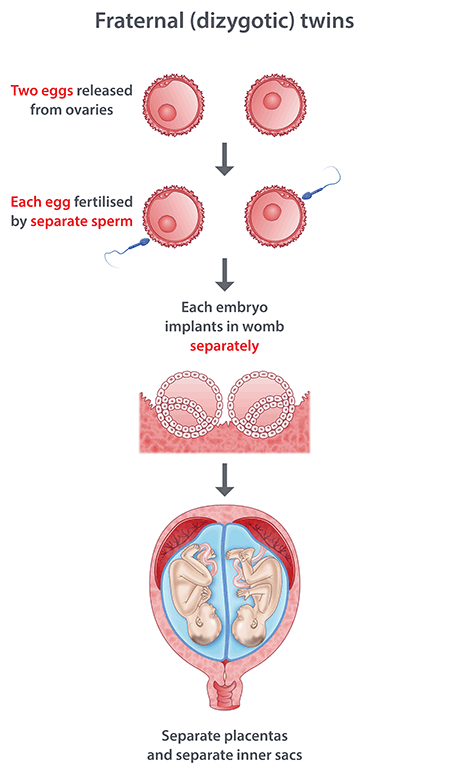- Normally, a woman gives birth to only one young at a time, but sometimes more than one child are born to a woman at the same time.
- The delivery of more than one baby by a mother is termed as multiple births.
- Most commonly in the case of multiple births, the number of births is two and the individuals which are born in such a way are called twins. Twins account for over 90 per cent of multiple births.
- In case of multiple births, the number of infants may be three (triplets), four (quadruplets), five (quintuplets) or even more (e.g., eleven).
Interesting Science Videos
Types of Twins
Twins are of two basic types:
-
Identical or Monozygotic Twins

- Twins having no variability in their traits are called identical twins.
- Identical twins possess identical genes and belong to the same sex.
Cause
Identical twins are produced from a single fertilized ovum. The two blastomeres resulting from the first cleavage (mitosis) of the fertilized egg or zygote separate from each other and develop into independent embryos.
Since, the two embryos have arisen by mitosis; they have the same chromosome sets in their body cells.
- The situation is the same for identical triplets and other multiplets, but they are quite rare in human beings.
- Sometimes, identical twins fail to separate completely from each other, they are called siamese twins.
-
Fraternal or Dizygotic Twins

- Non-identical twins contain different sets of genes and are like any other brothers and sisters, but just happen to grow simultaneously in the same uterus.
- Fraternal twins thus differ from each other in their traits, development and often even sex.
Cause
Non-identical or fraternal twins are produced by simultaneous fertilization of two separate ova by two separate sperms. Two foetuses so obtained from two zygotes are thus called dizygotic twins.
Known Factors that Increase the Odds of having Twins
Some women are more likely than others to give birth to twins. The factors include:
- Advancing age of the mother– women in their 30s and 40s have higher levels of the sex hormone oestrogen than younger women, which means that their ovaries are stimulated to produce more than one egg at a time.
- Number of previous pregnancies– the greater the number of pregnancies a woman has already had, the higher her odds of conceiving twins.
- Heredity – a woman is more likely to conceive fraternal twins if she is a fraternal twin, has already had fraternal twins, or has siblings who are fraternal twins.
- Race – Black African women have the highest incidence of twins, while Asian women have the lowest.
- Assisted reproductive techniques– many procedures rely on stimulating the ovaries with fertility drugs to produce eggs and, often, several eggs are released per ovulation.

Significance of Twins in Genetics- related Studies
- Twins are useful in detecting the relative effectiveness of heredity and environment upon the expression of a disease or trait.
- If a particular trait is shown by only one member of the identical twins, then it can be inferred that the environmental factor is playing the major role since both possess the same genes.
- Twins are used to study about the role genes play in shaping all types of human behaviour.
- Studies of identical twins separated since birth and not raised together have revealed that they exhibited many similar behavioural traits which inturn lead to conclusion that genes have at least 50 per cent influence on a paticular
References
- Verma, P. S., & Agrawal, V. K. (2006). Cell Biology, Genetics, Molecular Biology, Evolution & Ecology (1 ed.). S .Chand and company Ltd.
- https://www.betterhealth.vic.gov.au/health/conditionsandtreatments/twins-identical-and-fraternal
- Gardner, E. J., Simmons, M. J., & Snustad, D. P. (1991). Principles of genetics. New York: J. Wiley.
